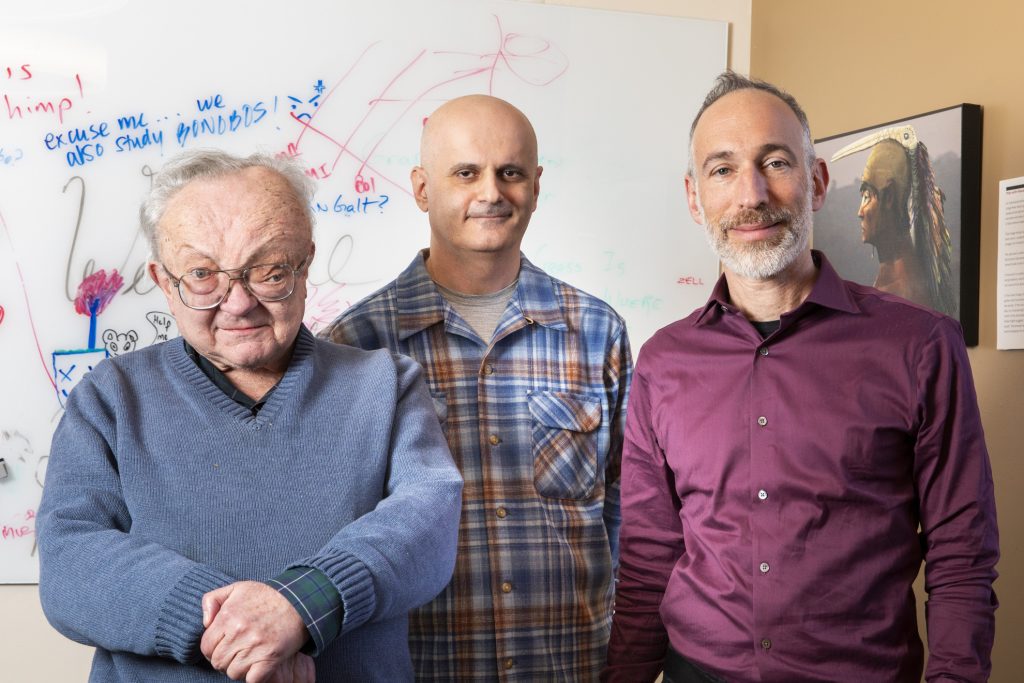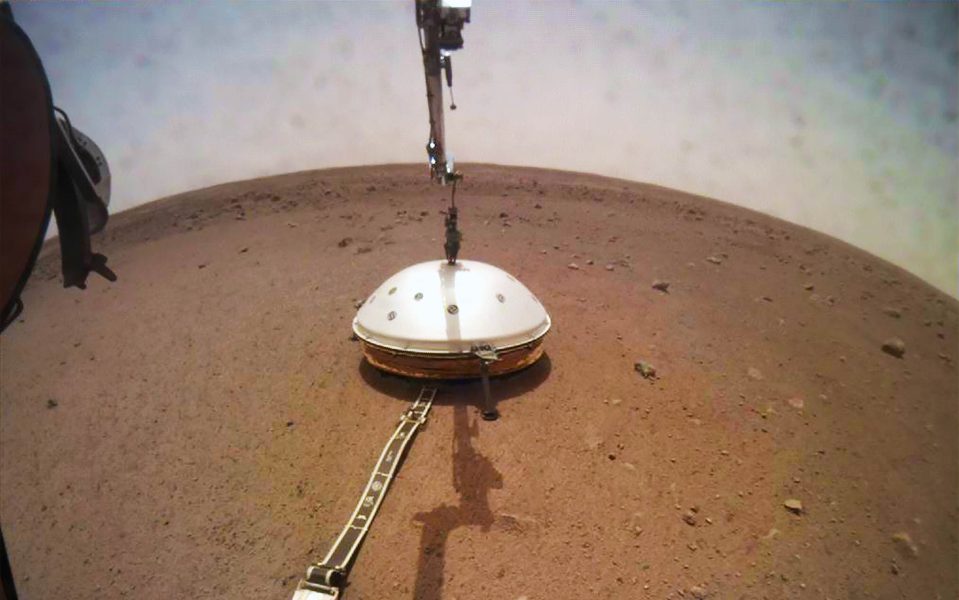Landmark studies track source of Indo-European languages spoken by 40% of world – Harvard Gazette

The co-authors of a study of ancient DNA, including (from left) Nick Patterson, a mathmetician and deputy lab head of the David Reich Lab, Iosif Lazaridis, a research associate in the Department of Human Evolutionary Biology, and David Reich, a professor of Human Evolutionary Biology in the Faculty of Arts and Sciences and professor of Genetics at Harvard Medical School, are seen in a portrait near their lab. The study, which focused on Yamnaya culture around the Volga River in eastern Europe, traced the originators of the Indo-European family of languages. The authors are pictured with an artistic representation of an individual found buried in an Eneolithic cemetery on the Volga River, key to their research. The individual wears an elk antler on their head, carved in the shape of a long-beaked bird. Veasey Conway/Harvard Staff Photographer
A series of random questions answered by Harvard experts.Nick Patterson (from left), Iosif Lazaridis, and David Reich. Veasey Conway/Harvard Staff Photographer
Christy DeSmith
Harvard Staff Writer A pair of landmark studies, published Wednesday in the journal Nature, has finally identified the originators of the Indo-European family of 400-plus languages, spoken today by more than 40 percent of the world’s population.DNA evidence places them in current-day Russia during the Eneolithic period about 6,500 years ago. These linguistic pioneers were spread from the steppe grasslands along the lower Volga River to the northern foothills of the Caucasus Mountains, with researchers dubbing them the Caucasus Lower Volga people. Genetic results show they mixed with other groups in the region.“It’s a very early manifestation of some of the cultural traditions that later spread across the steppe,” said senior author David Reich, a professor of genetics at Harvard Medical School and human evolutionary biology in the Faculty of Arts and Sciences. The research provides the missing piece of a longstanding linguistic puzzle.Scholars first noted similarities among the far-flung languages of Latin, Greek, and Sanskrit in the late 18th century. The so-called steppe hypothesis, formulated during the 19th century and formalized in the 1950s, postulated that speakers of the ancestor language of the Indo-European group lived on the Eurasian steppe. Scholars drew on linguistic reconstructions and archaeological evidence to place them in an area where Russia and Ukraine stand today.The storied Yamnaya people emerged as the leading contenders for the language family’s originators. The influential 2007 book “The Horse, the Wheel, and Language: How Bronze-Age Riders from the Eurasian Steppes Shaped the Modern World” by anthropologist David Anthony represented a deep dive into the Yamnaya’s role in disseminating a proto-Indo-European language that predated writing.These nomadic pastoralists were the first to “harvest the bioenergy of the Eurasian grasslands,” explained Anthony, an emeritus professor at Hartwick College in New York. The Yamnaya were probably the first to herd on horseback and early adopters (if not inventors) of oxen-towed wagons.“I don’t think we can even imagine what it was like for other people to see a wagon coming,” marveled Anthony, a co-lead author of the new research and a 2019-2020 visiting scholar in the Reich laboratory. “It was moving across the landscape, creaking and groaning, pulling a ton of equipment. People had never seen anything like it before.”With larger herds and superior mobility, the Yamnaya started exporting their economy — and their language — about 5,000 years ago. “They spread from the steppes north of the Black and Caspian seas all the way to Mongolia on one side and as far as Ireland on the other — 6,000 kilometers!” Anthony said.Nick Patterson, deputy head of Reich’s Harvard-based lab and an associate in the Department of Human Evolutionary Biology (HEB), remembers reading the book and discussing it at a conference a few years following its publication.“His book contained no genetics at all,” said Patterson, who is also a co-lead author of the new research. “But my genetic results were completely compatible with what he was saying.”Reich’s lab has been pursuing proto-Indo-European speakers for more than 15 years. In 2014, they shared key insights in a Nature article on what Reich called “the profound mixing event” that shaped modern Europeans, with most descended from three highly differentiated populations.The following year, the lab’s scientists offered a fuller picture of the continent’s Yamnaya set of ancestors. “They turned over the population of Europe with huge disruptions in Germany, Spain, Italy, Hungary,” Reich explained. “In Britain, there was a 90 percent-plus population replacement within decades.”The 2015 Nature paper credited the Yamnaya with carrying Indo-European languages across Europe and into the Indian subcontinent. Later papers, published by Reich’s lab and others, followed their genetic footprints into Greece, Armenia, India, and China.“It’s like a tracer dye,” Reich said. “You can actually see Yamnaya ancestry everywhere these languages went.”But researchers encountered a hitch within the Yamnaya line in the Anatolian peninsula. An extinct set of Indo-European languages was spoken there during the Bronze Age. Linguists have long believed they represent an early split from proto-Indo-European. During the 21st century, ancient DNA science surfaced similar conclusions.“We know people like the Hittites spoke Anatolian from cuneiform tablets,” Reich noted. “But these people didn’t have Yamnaya ancestry. We looked hard, with lots of data. We didn’t find anything. So we hypothesized some deeper population was the ultimate source in Indo-European languages.”The Caucasus Lower Volga people appear to be that original source, with newly uncovered links to both the Yamnaya and the ancient Indo-Anatolian speakers who inhabited an area that is now part of Turkey. The discovery marks a collaborative triumph that builds upon decades of work by linguists, archaeologists, and geneticists.“It’s the first time we have a genetic picture unifying all Indo-European languages,” said co-lead author Iosif Lazaridis, a research associate in HEB.“It’s the first time we have a genetic picture unifying all Indo-European languages.”But the Russia-Ukraine war forced an unusual splintering of the findings. A first paper, focused on the origins of Indo-European languages, draws on the ancient DNA of 354 individuals at archaeological sites in Russia and Southeastern Europe. A second, authored with researchers in Kyiv, is based on 81 ancient DNA samples drawn from Ukraine and Moldova. Also part of the analyses are genetic data on nearly 1,000 previously reported ancient individuals.“At present it’s very difficult for Ukrainian scholars to co-author with Russians,” Reich said.The first paper traces various lineages from the Caucasus Lower Volga people, including the Yamnaya and the Anatolians, while samples analyzed for the second provided rich new context on the “Yamna” (the Ukrainian term for Yamnaya). The paper finds evidence that the culture may have taken root somewhere near the small town of Mykhailivka in the southern part of the war-torn country.“Where the worst of the fighting is happening right now — that’s the Yamnaya homeland,” Anthony said.What is now clear is that a population of Caucasus Lower Volga people moved west and started mixing with locals, thereby forming the distinct Yamnaya genome.Co-authors David Anthony, Pavel Kuznetsov, and Oleg Mochalov on a treeless steppe in the Samara River valley in 1995.Credit: David Anthony, Pavel Kuznetsov, and Oleg Mochalov“We can see there was a small group of villages 5,700 to 5,300 years ago with just a couple thousand breeding individuals,” Reich said. “And then there was a demographic explosion, with these people going everywhere.” Language isn’t the only tradition the Yamnaya carried on from their Caucasus Lower Volga forebears. Both cultures buried their dead in kurgans, or large tombs with earth mounded on top. These graves, which still dot the region’s flat landscape, attracted generations of archaeologists and have now enabled “the genetic reconstruction of their makers’ origins presented here,” as Lazaridis wrote in the first paper.“Suppose the Yamnaya had a different culture,” Patterson offered. “Suppose they had cremated their dead. Chances are, we wouldn’t even know about this crucial culture in human history.”Some of the research for the papers was supported by the National Institutes of Health and the National Science Foundation.
Tech pioneer visits campus with his new memoir to discuss beauty of math, dropping out of College, founding Microsoft, value of curiosity
Groundbreaking pangenomic study suggests big DNA flip may have made small bird resistant to some diseases
Trapping molecules for use in systems may help make ultra-high-speed experimental technology even faster
Researchers place Caucasus Lower Volga people, speakers of ancestor tongue, in today’s Russia about 6,500 years ago
6 min read
Imani Perry’s lyrical new book weaves memoir, history to consider central place of a color in Black America
7 min read
Turns out neither. New research finds mayors on both sides mixed in implementing effective policies.
7 min read A series of random questions answered by Harvard experts.A series focused on the personal side of Harvard research and teaching.






